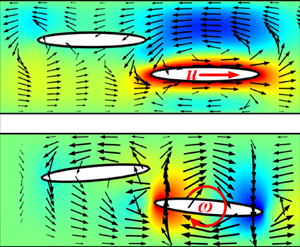Article contents
Hydrodynamic couplings of colloidal ellipsoids diffusing in channels
Published online by Cambridge University Press: 29 December 2021
Abstract

The hydrodynamic interactions (HIs) of two colloidal spheres characterized by the translation–translation (T–T) couplings have been studied under various confinements, but little is known regarding the HIs of anisotropic particles and rotational motions, which are common in nature and industry. Here, we study the T–T, rotation–rotation (R–R) and translation–rotation (T–R) hydrodynamic couplings of two colloidal ellipsoids sediment on the bottoms of channels in experiment, theory and simulation. We find that the degree of confinement and the particle shape anisotropy are critical tuning factors resulting in anomalous hydrodynamic and diffusive behaviours. The negative R–R coupling reflects the tendency of opposite rotations of two neighbouring ellipsoids. The positive T–R coupling reflects that an ellipsoid rotates away from the channel axis as another ellipsoid approaches. As the channel width increases, the positive T–T coupling changes to an abnormal negative coupling, indicating that the single-file diffusion can exist even in wide channels. By contrast, only positive T–T couplings were observed for spheres in channels. The T–T coupling increases with the aspect ratio p. The R–R coupling is the maximum at a moderate p ~ 2.8. The T–R coupling is the maximum at a moderate degree of confinement. The spatial range of HIs is longer than that of spheres and increases with p. We propose a simple model which reproduces some coupling phenomena between two ellipsoids, and it is further confirmed by low-Reynolds-number hydrodynamic simulation. These findings shed new light on anisotropic particle diffusion in porous media, transport through membranes, microfluidics and microrheology.
Information
- Type
- JFM Papers
- Information
- Copyright
- © The Author(s), 2021. Published by Cambridge University Press
References
- 8
- Cited by


